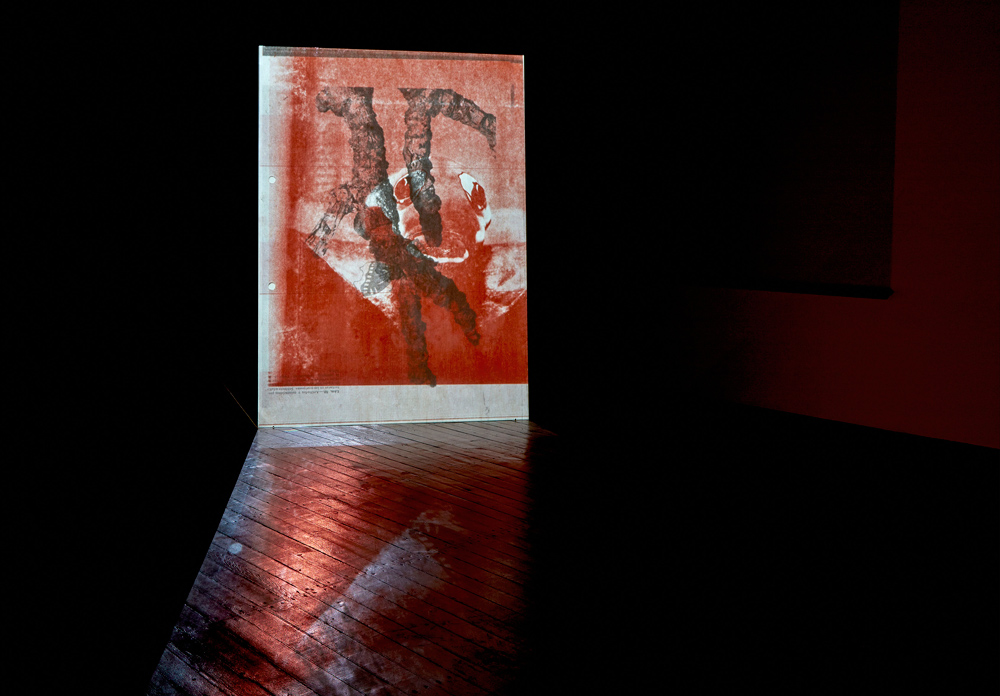Alexandre Estrela
Museo Nacional Centro de Arte Reina Sofía, Madrid, Spain
Museo Nacional Centro de Arte Reina Sofía, Madrid, Spain

In contrast to its schedule of vast retrospective exhibitions, the Museo National Centro de Arte Reina Sofía’s ‘Fisuras’ (Fissures) series showcases new productions. As the moniker suggests, these presentations are intended as interstices between the monolithic slabs of the programme. Alexandre Estrela’s exhibition, ‘Pockets of Silence’, is no exception. The Portuguese artist’s reflection on special-operations warfare through film and sound, and his quite literal exploration of the laboratory-like art space, makes his exhibition strategy seem all the more felicitous. Projected onto a sheet of glass in the otherwise wood-panelled Protocol Room, Vida y Costumbres de Alexander (The Life and Customs of Alexander, 2015) functions as an anxious overture or epilogue. The work is a sequences of shadowy, superimposed duotone images – of moths and magnified charts, webs and organic graphemes – that dissolve into each other to the sound of a 1969 electronic drone score composed by Éliane Radigue.
On entering Espacio Unio, visitors are confronted by a sensory assault from two further video and audio works (Pockets of Silence and Pockets of Silence 2, 2015). We hear the shrill din of a hovering helicopter. Beamed through a spinning block of clear acrylic, a video projector throws a cryptic moving image onto a free-standing wall: rotor blades whirr behind what appears to be the rendering of the corner of a room. The piercing sound of cicadas screeches from the adjoining gallery where the image from a companion video spills over the leaning screen and large sphere it is fixed to; the pupil-like hole at their conjoined centres forms a peering, disembodied eyeball. Video frames pulse rapidly – a violent burst of still photographs animates footage of a polystyrene buoy lodged in tree roots on a tropical beach. Yet the metallic timbre of the insect noise and the harsh stroboscopic effect of the video are migraine-inducing, almost sickening. This writer is making for the exit; then everything stops. A brief lull. In the first gallery, the image is frozen and refracted obtusely as the acrylic block has stopped spinning. It becomes apparent that there is a scientific paper from 2012, enlarged and framed on the wall, which details laboratory experiments on rats: ‘Silence resulting from the cessation of movement signals danger,’ it states, concluding that there is a neural and learned basis for fear when things go eerily quiet.

Estrela’s point of departure is a combat tactic conceived by Cesare Dante Vacchi, a maverick ex-French Foreign Legionnaire, who was employed as a military strategist in 1961 by Portuguese special forces during the colonial war in Angola. Vacchi had commandos play tapes of pre-recorded forest sounds as they walked trails, in case the forest were to fall silent and betray their presence to the enemy. Although Estrela’s project bleeds nauseously into the dark past of Portuguese colonialism through the Colonel Kurtz-like figure of Vacchi, Estrela does not yoke the project to historical denunciation. Neither does he present the animal testing of the scientific study, carried out by his neuroscientist partner, with any particular degree of ethical advocacy. Instead, the exhibition is unflinchingly couched as a formal and perceptual exercise, a filmic ploy. What makes it all the more perplexing is that the stoppages aren’t the dread-inducing freezing of an environment to which one has become accustomed, but respites from the oppressive auditory and visual onslaught.
























